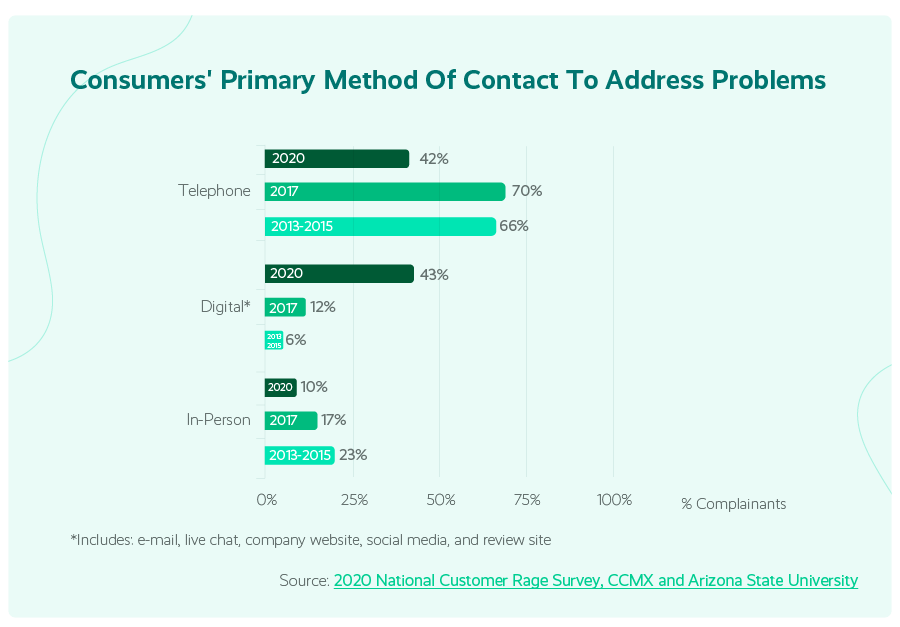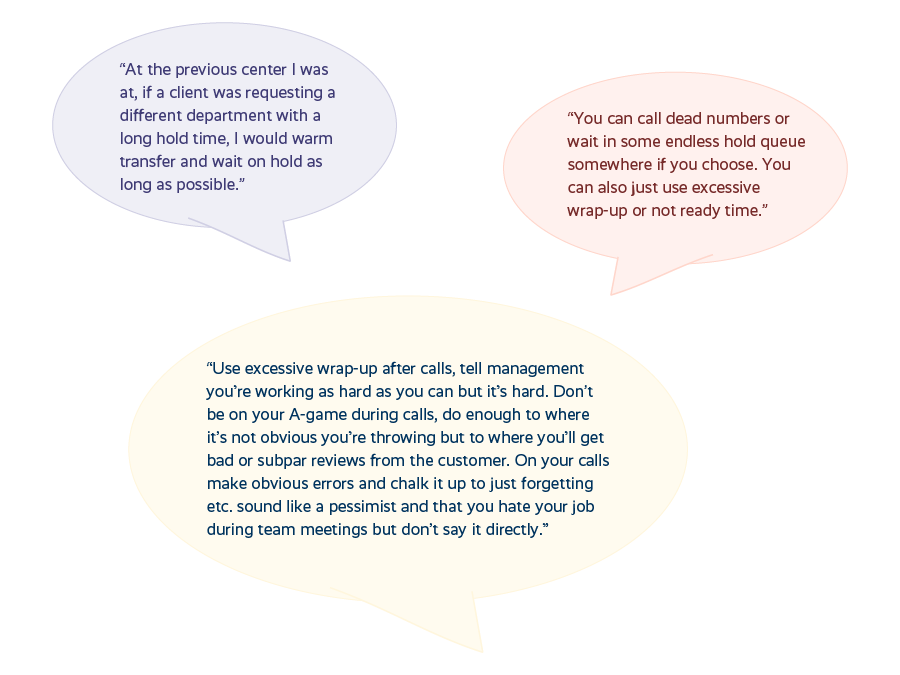Why Your Contact Center Needs A Call Avoidance Policy
Call avoidance is a common issue in contact centers and must be dealt with to ensure a positive experience for your customers. But agents can quickly become frustrated and overwhelmed when dealing with irate customers and high contact volumes, leading them to avoid interactions.
While the issue is not unusual, it’s easier to manage if you have a solid call avoidance policy in place. When you create the right policy, you’ll get call avoidance rates down — to the benefit of both your customer satisfaction metrics and your agents’ experiences.

Customer Rage And Pandemic Rage
Research from the California Management Review describes customer rage and the effects it has on a business:
“Customer rage is an intense anger coupled with expressions of physical, verbal, or other potentially harmful behaviors in response to a dissatisfying service experience. It can potentially result in severe negative consequences for firms, employees, and even other valued customers.”
In addition to customer rage, we now have pandemic rage. “In the context of this prolonged pandemic, people are experiencing a broad range of difficult emotions, including anxiety, worry, sadness, despair, and guilt,” said Lisa MacLean, M.D., a psychiatrist at Henry Ford Health.
“But one emotion stands out above the rest and that is anger,” she continued. “Anger is a normal reaction to stress. It’s a sign of our distress and an example of our suffering. We have all experienced social isolation, a loss of routine, increased fear, and prolonged uncertainty, grief, and loss—even grieving the way things used to be.”
Both of these are a formula for a bad experience for customers, creating negative customer sentiment and potentially affecting your revenue.

While to the agent, it’s just handling another customer interaction, they are the “face” of the company and take the brunt of the rage from the customer. When customers are in a rage, it can be incredibly difficult to defuse the situation, creating stress and burnout for your agents.
Related Article: How Contact Center Agent Burnout Decreases Productivity (And What You Can Do About It)
Examples Of Interaction Avoidance
One way agents deal with this is call avoidance or, in our digital age, interaction avoidance. Avoidance behavior can happen regardless of the nature of the business, location, or even if the agents are in the office or fully remote.
A few examples of avoidance strategies by agents include:
- Logging into the system then immediately going to a not-ready code to prevent any interactions coming through
- Disconnecting the customer interaction before greeting or resolution
- Transferring a customer back into the queue or to another department or agent unnecessarily
- Placing customer on hold or mute until the customer disconnects
- Switching codes rapidly within a few seconds to put the agent at the back of the line for the next interaction
- Claiming IT issues with their systems so they are unable to work
- Staying in post-interaction status toward the end of the shift to avoid any further interactions
- Calling their own phone, family, friends or handling personal issues when making outbound calls
- Taking unnecessary, unauthorized, or excessive personal break time
The reality is people are apt to “cut corners” to make their day easier, and it’s no different in a customer service center environment where stress levels and turnover are high. Agents are dealing with numerous customers with different personalities and different communication skills.
This can all get frustrating very quickly, and the old customer service standard of “service with a smile” can add even more pressure to an already overwhelmed customer service agent. So much so that a general Google search will return numerous examples of avoidance behaviors.
Below are a few comments from agents when someone asked for “good call avoidance schemes” on an agent forum.

While the above examples refer to voice call avoidance strategies, there are just as many ways for agents to avoid digital interactions like chat, emails, or social media messaging. For instance, an agent might opt to work only on simple tickets or responses, leaving more complex interactions for other agents.
No matter what channels your service center offers, you can be certain that as you become more strict on interaction avoidance, some agents will just become more creative in avoiding their work.
Related Webinar: Retaining Agents with a Mindful Culture: Methods to Improve the Contact Center Experience
Other Avoidance Factors To Consider
When you’re creating a contact avoidance policy, it’s always best to look to the agent for a reasonable explanation as some strict policies can punish an agent for circumstances outside of their control.
For example, what if a tornado siren has sounded and the agent must take cover immediately? While we would all hope the agent would remember to log out of the system in this type of situation before taking cover, that’s not always going to be the case in a chaotic circumstance like that.
Another example is if an agent is personally expecting a life-threatening emergency, the last thing one would think of is to log out of the system while the paramedics are attending to the issue.
In both of these cases, on the surface, many contact center leaders would see an instance of interaction avoidance without seeing that a true underlying issue was involved. Tip: Best practice is to be able to remotely log the agent out of the queues as soon as possible so no further phone calls or other interactions occur.
And don’t forget all that customer rage agents are dealing with each day. Some agents avoid calls just to get a break from stressful interactions with angry customers.
Avoidance isn’t the right solution to this problem, so look at other ways to reduce agent burnout by stopping call avoidance before it starts. Try mixing up an agent’s schedule to give them some stress relief, letting them spend time away from voice and work on chats, emails, or support tickets instead.
Related Article: 5 Proven Strategies To Help Remote Contact Center Agents Feel Valued
6 Tips For Writing Your Contact Avoidance Policy
- A customer interaction or call avoidance policy should be very clear about what is or is not acceptable.
- The policy should clearly define what is considered call avoidance or interaction avoidance.
- Clearly define all of the consequences and corrective actions that will be taken if a certain number of call/interaction avoidance instances are detected in a given period of time.
- Define procedures for reporting emergencies that may impact the agent’s ability to handle the call or digital interaction.
- Listen to the employee. Let them tell their side of the story.
- Determine what underlying issue is causing the issue, such as lack of training, long processes, etc.
Related Article: How to Control Call Avoidance and Interaction Avoidance

Call Avoidance Policy Template
It’s best practice to have an interaction/call avoidance policy in place. While many companies have a zero-tolerance policy regarding contact avoidance, this is not always ideal. As discussed above, there are sometimes legitimate reasons avoidance occurs.
Collaborate with your service center management and senior leadership on implementing a policy as well as the disciplinary category the issue would fall under. Once a policy is agreed upon, ensure it is sent out to current employees as well as future new hires so that everyone is on the same page.
Below is a template that can be used to set up your own call/interaction avoidance policy.
Name of the Policy
Example: Call Avoidance, Digital Interaction Avoidance, RONA & Call Dumping Policy
Purpose of the Policy
Example: The company maintains a progressive discipline policy to identify and address employee-related problems in the workplace. This policy applies to all employee conduct that the company, in its sole discretion, determines must be addressed through disciplinary measures.
Policy Statement and Definitions
Call avoidance, digital interaction avoidance, reroute on no answer (RONA), and call dumping are not permitted acts of conduct.
Call Avoidance: Provide description and examples of call avoidance
Digital Interaction Avoidance: Provide description and examples of digital interaction avoidance
Disciplinary Action
List offenses and consequences such as a probationary period, performance improvement plan, etc.
Related Article: How to Identify and Address Call Avoidance
Reduce Call Avoidance With Coaching And Training
Given the current employment market, it can be a big advantage to find ways to correct behaviors and retain agents rather than going through the costly process of firing them and recruiting new staff.
When you’re trying to get call avoidance under control, a software solution that allows you to intervene before taking disciplinary measures can be effective.
- Online learning lets agents learn at their own pace in the office or remotely, helping agents understand the consequences of call avoidance from the start.
- A coaching solution that allows you to customize training for each agent will help you address call avoidance issues with the agents who need it most.
- The right performance management solution will help you consistently monitor your agents’ KPIs so you can put a stop to call avoidance before it becomes a larger issue.
Related Article: Five Coaching Tips For Contact Center Agents that Work
Create A Strong Call Avoidance Policy To Safeguard Customer And Agent Experience
Creating the right call avoidance policy isn’t all about punishment. It’s about designing a set of guidelines that takes into account the causes of avoidance and clearly lays out the proper definitions, examples, and consequences. When everyone is clear on what call avoidance is, it’s easier for agents to follow and contact center leaders to enforce.
Learn more strategies for handling call avoidance in our ebook, Combatting Contact Avoidance And Creating The Right Policy To Manage It, or request a demo to see how Playvox solutions can help you monitor and manage contact avoidance in any channel.






